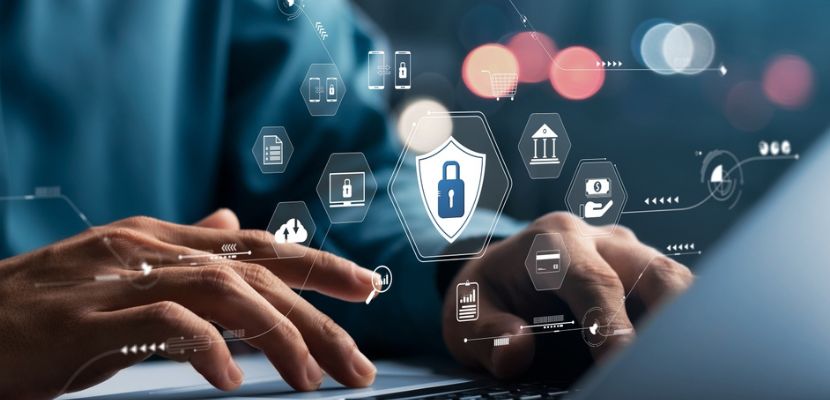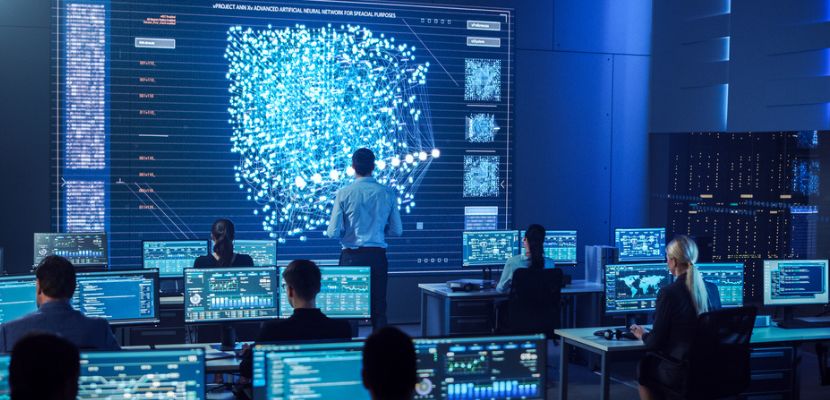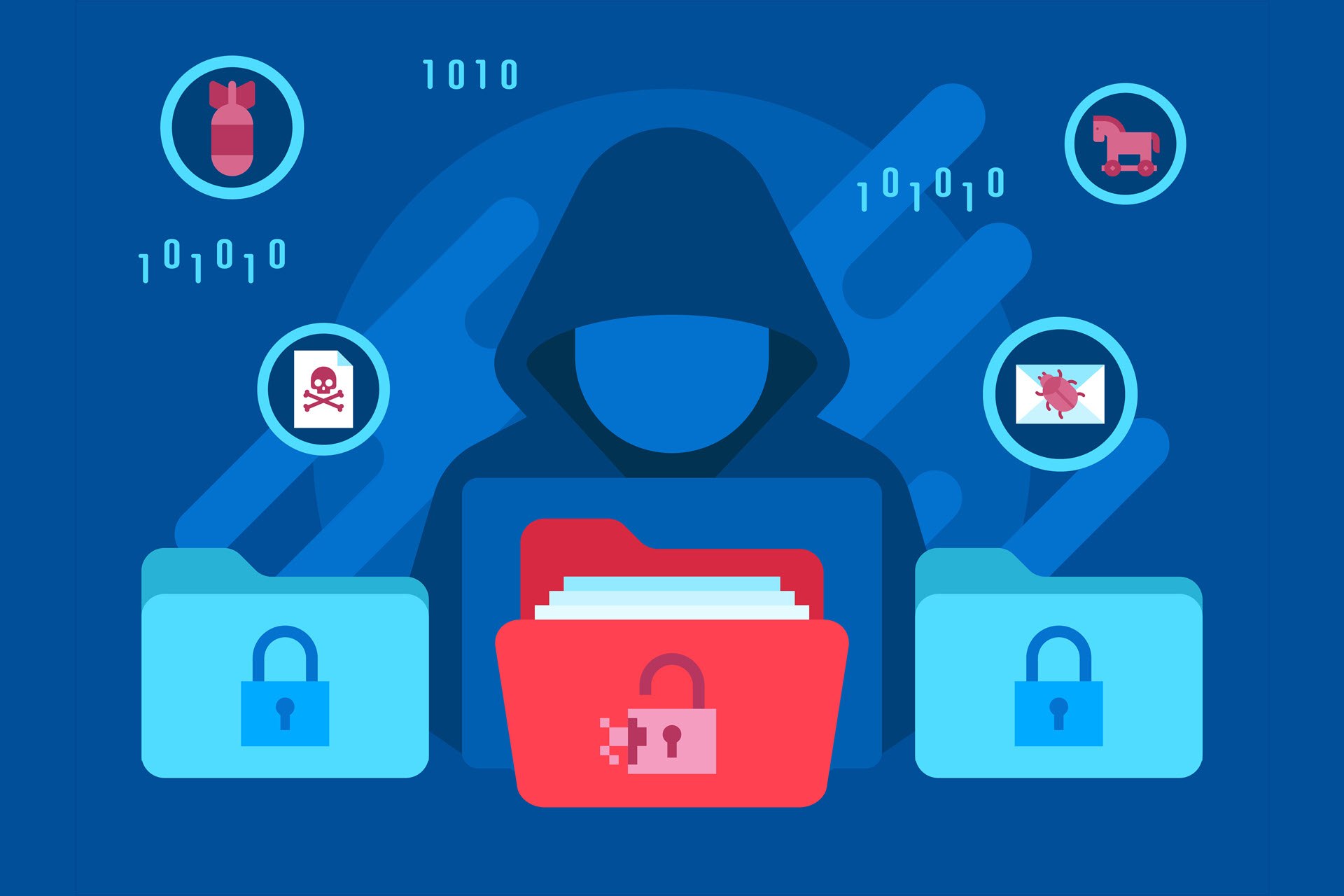The plethora of threats individuals and organizations face in today’s digital landscape makes it essential to dedicate resources to cybersecurity. By designing and implementing robust cybersecurity strategies, organizations protect their sensitive data and systems from unauthorized access, downtime, and financial loss.
This article explains everything you need to know about cybersecurity, its importance, and the types of cyber threats organizations today face.

What Is Cybersecurity?
Cybersecurity is the practice of protecting computer systems, networks, and sensitive data from digital attacks and unauthorized access. Cybersecurity techniques and strategies aim to safeguard the integrity, confidentiality, and availability of an organization’s digital systems, personal information, financial records, and intellectual property.
The scope of cybersecurity encompasses all aspects of threat prevention, involving the implementation of layers of protection across an organization’s entire digital ecosystem. While cybersecurity is founded on technological solutions such as firewalls and antivirus software, its effectiveness depends on raising awareness among employees and providing continuous education on cybersecurity measures.
Cybersecurity Examples
Cybersecurity encompasses various strategies and practices that protect digital systems from cyber threats, including:
- Firewalls. These network security systems monitor and control incoming and outgoing network traffic to differentiate trusted from untrusted connections.
- Encryption. Involves encoding data at rest, in use, and in transit to prevent unauthorized access.
- Antivirus software. This software detects, blocks, and removes malware, such as viruses, worms, or trojan horses in real time.
- Virtual private networks (VPNs). VPNs allow users to securely send and receive data across shared or public networks.
- Two-factor authentication. This method adds another layer of security by requiring two different forms of identification before granting access to sensitive information and systems.
- Secure Socket Layer (SSL) and Transport Layer Security (TLS) protocols. These protocols secure internet connections and protect sensitive data during transfer.
- Intrusion detection systems (IDS) and intrusion prevention systems (IPS). These systems monitor network traffic for suspicious activity, send alerts, and block threats before they cause damage.
- Phishing protection. These measures protect systems from phishing attacks, and they include email filtering and educating personnel on how to recognize and prevent cyber threats.
- Data loss prevention (DLP) technologies. These systems ensure that sensitive data is never accessed by unauthorized individuals.
- Security information and event management (SIEM) tools. SIEM tools collect and analyze log data to detect suspicious activities.
- Patch management. These methods ensure regular updating of software and systems to improve security and fix vulnerabilities.
- Cybersecurity incident response planning. This includes preparation for, responding to, and recovering from cybersecurity incidents.
- Mobile device management (MDM). These policies secure and manage the use of mobile devices when accessing company data.
- Security awareness training. These programs aim to educate employees on the risks of cyber attacks and how to prevent them.
- Risk assessment and management. These methods identify, assess, and implement strategies to manage potential cyber threats.
Types of Cybersecurity Threats

Threats to digital systems evolve constantly, with cybercriminals using technological advancements to finetune their malicious tactics. Below is a list of common types of cyber attacks.
1. Malware
Malware is an umbrella term for any software that targets computers, servers, clients, or networks to steal sensitive information, disrupt operations, or gain unauthorized access. It encompasses a range of programs with distinct behaviors and attack strategies.
Malware is typically distributed through email attachments, compromised websites, or via software vulnerabilities. These are the most common forms of malware:
- Viruses, which replicate themselves and spread to other devices.
- Worms, which exploit network vulnerabilities and spread without user intervention.
- Trojans, which are disguised as legitimate software to trick users into installing them.
- Ransomware, which encrypts files and demands payment for their release.
Learn how to recognize the differences between malware and ransomware.
2. Phishing
Phishing is a type of cyber attack where the victim is manipulated into divulging sensitive information or authorizing money transfers through an email, text, or phone call. Phishing criminals rely on social engineering and exploit human psychology to deceive their victims. Attackers pose as trusted sources, colleagues, and authority figures, and induce a sense of urgency or fear in their targets, playing on their emotions.
Over time, phishing has become more sophisticated. Spear phishing is a targeted phishing attack aimed at specific individuals. It involves sending customized emails that contain personal information about the targets, making them more convincing and difficult to recognize. Whale phishing is another form of focused phishing. It targets a high-ranking individual in an organization, whose high level of access or authority increases the rewards if the attack is successful.
3. Ransomware
Ransomware is malicious software that encrypts and blocks access to data and systems. The cybercriminals then demand that the victim pay a certain amount of money (ransom) to regain access to their data. These attacks target individuals, businesses, and government agencies, causing serious operational disruptions, financial losses, and reputational damage.
The attackers usually demand a payment in cryptocurrencies, making it difficult to trace the felons. Even if the organization pays the ransom, there is no guarantee that the data will be recovered. Recovery from this type of attack is lengthy and expensive, as it requires professional intervention to restore data and secure the network.
Explore our suite of cloud-based ransomware protection solutions.
4. Denial-of-Service (DoS) and Distributed Denial-of-Service (DDoS) Attacks
Denial-of-service (DoS) attacks aim to overwhelm a system, network, or website with traffic, disrupting its functioning and making it inaccessible to users. A DoS attack floods the system with a vast number of requests to overload it and prevent legitimate requests from being fulfilled. This exhausts the capacity of network resources, causing slowdowns or shutdowns.
Distributed denial-of-service (DDoS) attacks are a more complex and powerful variant of DoS attacks. They rely on a network of compromised computers (botnet) to flood the victim with a considerable amount of internet traffic from diverse sources. DDoS attacks originate from thousands of unique IP addresses, making it challenging to differentiate between legitimate and malicious traffic and effectively block the attack.
DDoS attack prevention made easy: learn more about our proprietary, automated, and intelligence-driven DDoS protection solution.
5. Man-in-the-Middle (MitM) Attacks
Man-in-the-middle (MitM) attacks occur when an attacker intercepts and alters communication between two parties without them knowing. The goal is to eavesdrop on the conversation and gather sensitive information, such as login credentials, credit card numbers, or personal data, which can then be manipulated.
MitM attacks are commonly executed through unsecured public Wi-Fi networks or software vulnerabilities in the network infrastructure and are typically difficult to detect. During a MitM attack, an attacker intercepts the data traffic in one of two ways:
- IP spoofing, where the attacker deceives the system into thinking they are a trusted source.
- DNS spoofing, where the attacker interferes with the domain name system resolution process.
6. SQL Injections
SQL injections are a form of cyber attack that allows attackers to interfere with queries applications make to databases. The SQL query is “injected” into the application via the input data from the client. A successful injection can read sensitive data in the database, modify it, execute administration operations, and even issue commands to the operating system, compromising data integrity.
SQL injections typically occur due to web application software vulnerabilities that allow SQL commands to be executed unknowingly by the server without previous input sanitization. SQL injections can be prevented by following secure coding practices, such as input validation and parameterized queries, and by using prepared statements that enable applications to distinguish between code and data.
7. Zero-Day Exploits
Zero-day exploits take advantage of a security vulnerability on the same day it becomes known to the public and before a solution is implemented. The term “zero-day” implies that developers have zero days to fix the issue before data theft or other disruptions occur. These attacks bring high rewards because they can be exploited to gain unauthorized access to systems by targeting software, operating systems, browsers, and applications.
Zero-day exploits are unpredictable and challenging to prevent and remediate. They are particularly dangerous as there are no specific patches or preventive measures that can be implemented when the attack takes place. To mitigate risks, organizations must implement proactive and layered security solutions that include advanced threat detection, regular security audits, and robust backup and disaster recovery processes.
phoenixNAP helps you protect your business with backup and restore solutions that leverage state-of-the-art technologies to ensure continuity and availability even during a disaster or outage.
8. Rootkits
Rootkits are a type of malicious software that aims to gain unauthorized root or administrative access to computers and networks. Because they often hide their existence, they are tough to detect and can modify files to tamper with operating system functions. Rootkits modify system files and kernel modules, enabling cybercriminals to execute files, steal information, modify system configurations, or disable system updates and antivirus software, often undetected.
Rootkits are frequently installed through phishing attacks, by exploiting vulnerabilities, or by piggybacking on legitimate software installations. Once installed, they intercept and alter system calls, hide files, registry keys, and processes, or log keystrokes and capture user screen output. Their prevention requires deep system scanning, regular system and software updates, and particular user vigilance.
9. Advanced Persistent Threats (APTs)
Advanced persistent threats (APTs) are prolonged cyber attacks performed by highly skilled cybercriminal groups who aim to steal data or cause long-term disruption of operations. They are commonly aimed at government agencies, larger corporations, and critical infrastructure.
APTs are meticulously planned and executed to avoid drawing attention or triggering alarms. Once within a system, they move laterally and stay there for as long as possible, planting multiple backdoors to ensure access even if an entry point is discovered and closed.
APT attacks monitor network activity and, over time, extract valuable information, such as intellectual property, military secrets, or sensitive government data. They remain undetected thanks to encryption, deleting logs, and mimicking regular network traffic. To combat APT attacks, organizations must implement advanced security measures, including anomaly detection, behavioral analytics, continuous monitoring of network traffic, and strong incident response protocols.
10. Drive-by Attacks
Drive-by attacks install malware, such as ransomware, spyware, and trojans, onto computers through vulnerable web pages. They do not require any action from the victim, such as downloading a malicious file; the attack is triggered simply by visiting an unsecured website. Drive-by attacks easily spread to a broad audience and are hard to avoid, as they can appear even on trusted websites.
The compromised code is usually injected into the webpage through suspicious advertising content or by hacking the website. When a user visits the website, the code exploits browser or plugin vulnerabilities to install malware on their computer.
Protection from drive-by attacks includes keeping browsers and plugins updated, using antivirus and anti-malware programs with real-time protection, and exercising caution when browsing the web.
Ransomware is a particularly malicious form of cyber attacks with far-reaching consequences. Read our blog article about the various ways ransomware is delivered so you can stay protected.
11. Cross-Site Scripting
Cross-site scripting (XSS) is a common web security vulnerability that allows attackers to inject malicious scripts into web pages. It occurs when a web application uses unvalidated or unencoded user input in its output. These scripts gain access to any cookies, session tokens, or other sensitive user information that the browser retains to perform unauthorized actions on behalf of the user.
The most common types of XSS attacks are reflected XSS, where the malicious script comes from the current HTTP request, and stored XSS, where the script is stored permanently on the server or a database and displayed to users. The consequences of XSS attacks range from minor nuisances to data breaches, session hijacking, website defacement, and malware spread.
Developers combat these attacks by ensuring that web applications do not embed untrusted data in the generated output via secure coding practices, input validation, and output encoding.
12. Password Attacks
Password attacks attempt to gain unauthorized access to sensitive data by guessing or stealing passwords. They are the most common types of security breaches and rely on several methods:
- Brute-force attacks, which involve trying every possible combination of characters until the right one is found.
- Dictionary attacks, where inolve the attackers trying to use common words and phrases.
- Credential stuffing, which involves using previously stolen usernames and passwords on multiple sites.
- Keystroke logging, where the cybercriminals capture the passwords as the user inputs them.
- Social engineering, which involves the victim being manipulated into revealing the password themselves.
Individuals and organizations are advised to employ proven techniques for protecting their passwords, such as multi-factor authentication, encryption, and common sense. Passwords should never be written down, shared with others, or used on multiple websites and accounts.
phoenixNAP’s password generator tool helps you generate strong, complex, and secure passwords.
Why Is Cybersecurity Important?
There are multiple reasons for taking cybersecurity seriously, as a cyber attack can compromise individual privacy, business and national security, financial stability, and reputation. Here are the outstanding reasons why security should be at the forefront of any digital system:
- Protection of personal information. Cybersecurity safeguards personal information, including social security numbers, bank account details, and health records, from theft and misuse.
- National security. Cybersecurity protects critical national infrastructure such as power grids, voting systems, and defense systems.
- Business continuity and protection. Cybersecurity protects the operational integrity of organizations from attacks that could compromise sensitive data and cause financial and reputational damage.
- Trust and credibility. Cybersecurity helps organizations preserve their reputation and the trust of customers, stakeholders, and the public.
- Financial loss prevention. Cybersecurity measures protect organizations from the financial implications of data breaches that include not just immediate losses but also long-term reputational damage and legal liabilities.
- Protection against emerging threats. Cybersecurity strategies constantly evolve and improve to respond to the ever-changing threat landscape.
- Regulatory compliance. Cybersecurity safeguards sensitive information, ensuring organizations comply with the regulatory standards of their respective industries.
- Global economic stability. Cybersecurity contributes to the stability of the world’s economy by preventing market disruptions that result from cyber attacks.
- Intellectual property protection. Cybersecurity protects intellectual property from theft, which is the core asset of any organization.
- Societal trust in technology. Cybersecurity ensures that users are safe when using technology, maintaining trust in systems and services.
What Are Cybersecurity Challenges?

Cybersecurity is a complex undertaking, and implementing robust measures involves a range of challenges. Here are some of the key difficulties of pursuing security in today’s digital environment:
- Rapidly advancing cyber threats require cybersecurity measures to develop equally rapidly if they are to remain effective against the increasing sophistication of attacks.
- The infrastructural complexity of modern IT environments, which combine cloud-based services, on-prem systems, and mobile networks, makes it challenging to integrate cybersecurity measures across these diverse systems.
- Resource constraints within an organization’s budget, personnel, and technology often block the implementation of effective cybersecurity measures.
- Social engineering attacks are becoming more sophisticated, causing damage that is difficult to repair.
- Insider threats, whether accidental or intentional, significantly diminish cybersecurity efforts.
- The rise of the Internet of Things (IoT) and smart devices has expanded the potential attack surface and introduced new vulnerabilities.
- Regulatory compliance requirements change frequently, making it necessary to regularly monitor and update systems to ensure the safety of data and privacy.
- A lack of cybersecurity awareness and training makes an organization more prone to cyber attacks.
- Third-party vendors and supply chains introduce further cyber risks as attackers exploit vulnerabilities in less secure elements.
- Securing mobile devices is critical due to the increased use of these devices for personal and professional purposes.
- Data and alert overload, which cybersecurity teams face, makes it challenging to respond to legitimate threats when they occur.
- Securing remote access to networks introduces new cybersecurity challenges as the organization’s perimeter expands.
- Balancing user experience and security is challenging because many cybersecurity measures can disrupt user experience.
- Global coordination and the sharing of intelligence become vital as cyber attacks often cross national borders.
Cybersecurity Best Practices
Here are the best cybersecurity practices organizations should implement to make the most out of their cybersecurity strategies:
- Regularly patch and update software to protect it against vulnerabilities.
- Implement multi-factor authentication for all credentials.
- Use strong and unique passwords, and do not share them with anyone.
- Train employees on how to recognize and prevent cyber attacks.
- Regularly back up data off-site.
- Secure Wi-Fi networks with different types of firewalls.
- Use antivirus and anti-malware software.
- Regularly perform security audits and risk assessments in-house or through third-party experts.
- Control access to sensitive information on a need-to-know basis and the principle of least privilege.
- Design a robust incident response plan.
- Secure hardware and software configuration to minimize vulnerabilities.
- Encrypt sensitive data in transit and at rest.
- Implement email security measures to filter spam and suspicious attachments.
- Segment networks to separate critical systems and data, thereby reducing the attack surface.
- Secure development practices are applied throughout the entire software development lifecycle.
- Use intrusion detection systems (IDS) to monitor and control incoming and ongoing traffic.
The Cybersecurity Imperative: Protecting Your Digital Future
Cybersecurity is an indispensable aspect of today’s digital landscape as it provides vital protection of sensitive information of individuals, companies, and nations. As cyber threats become more sophisticated, it is essential to remain vigilant and proactive by implementing robust cybersecurity solutions.



